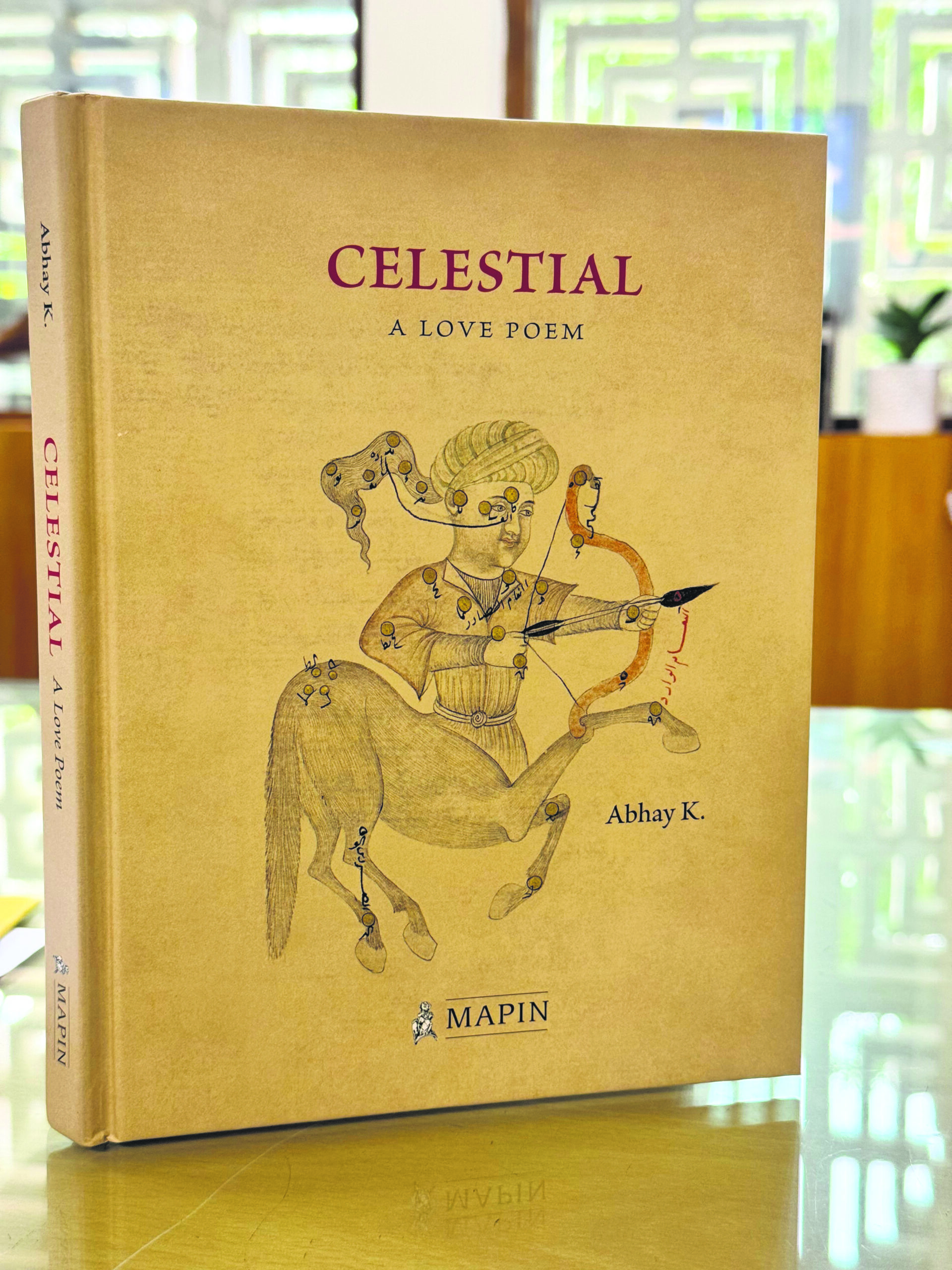In this interview, Abhay K. talks about his experience of writing ‘Celestial’, journey as a poet, translator, and editor, and his upcoming works.
The luminary Persian astronomer Abd al-Rahman Al-Sufi, known in the West as Azophi, forever changed the way we look at the stars in the sky. As one of the world’s most influential astronomers, he dedicated his life to furthering our understanding of the stars and constellations. In the year 964 AD, Al-Sufi published his findings in his Arabic book titled Kitab al-Kawatib al-Thabit al-Musawwar, or The Book of Fixed Stars.
More than a millennium later, Indian poet and diplomat Abhay K, through his love poem ‘Celestial,’ has reminded us of Al-Sufi’s towering work that over the last many centuries has continued to shape the world’s view of the night sky.
Celestial, a love poem of 100 rhyming couplets, takes the reader on a poetic journey to all the 88 star constellations visible from Earth. In the process, Abhay invokes Al-Sufi by using his exquisite illustrations of 48 constellations from The Book of Fixed Stars to go along with his couplets.
The thought of writing Celestial came to Abhay during his tenure as the Ambassador of India in Madagascar from 2019 to 2022.

In this interview, Abhay K talks about his experience of writing ‘Celestial,’ journey as a poet, translator, and editor, and his upcoming works.
Excerpts
Q. What inspired you to write ‘Celestial’? How did the work of Abd al-Rahman Al-Sufi influence or inspire your approach to ‘Celestial’?
A. During my stay in Antananarivo, capital of Madagascar, I was fortunate to have spotted several bright star constellations with my naked eyes. One night I woke up at 2 am and looked out of the window and saw the constellation of Scorpius shining bright in the east. A poem started taking shape in my mind:
Awake each night
I savour starlight
before the blinding sunlight
obliterates you from my sight
After the completion of the poem, when I started thinking of illustrations that could possibly accompany the couplets, I came across the exquisite art work of Abd Al Rahman Al Sufi illustrating star constellations.
Q. Can you describe your creative process in crafting 100 rhyming couplets? What kind of research did you undertake to ensure accuracy in depicting the various constellations and their characteristics in poetic form?
A. The thought of writing Celestial was conceptualized during my stay in the Indian Ocean island of Madagascar between 2019 and 2022. Antananarivo skies are clear and free from light pollution during most part of the year, and so I started gazing at the night sky more attentively and carefully and was duly rewarded with sighting of all the planets in our solar system that can be seen with the naked eye as well as the most prominent star constellations such as Orion, Canis Major, Taurus, Scorpius, Centaurus, Vela, Carina, Sagittarius, and Libra among others and some bright stars such as Sirius, Canopus, Betelguese, Rigel, Aldebaran, Antares, to name a few. This also set me on the path of writing anthems on the planets of our solar system, which were published on 21st December 2020, on the day of the Great Conjunction of Jupiter and Saturn. I was fascinated by the stories and mythologies associated with constellations and started reading about them in depth.
During my university days I had read a part of the poem ‘Locksley Hall’ by Lord Alfred Tennyson and carried a piece of paper in my wallet for a long time with the lines. It was in Antananarivo that I got the opportunity to read the complete ‘Locksley Hall’ which was inspired by Sir William Jones’s prose translation of ‘Mu’allaqat’, a group of seven long Arabic poems. ‘Locksley Hall’ consists of 97 rhyming couplets and makes reference to the constellation of Orion and the asterism Pleiades:
Many a night from yonder ivied casement, ere I went to rest,
Did I look on great Orion sloping slowly to the West. 4
Many a night I saw the Pleiads, rising thro’ the mellow shade,
Glitter like a swarm of fire-flies tangled in a silver braid. 5
Inspired by this poem, I set to writing ‘Celestial’ consisting of 100 rhyming couplets that could take the readers on a cosmic journey to all the star constellations visible from Earth, some bright, some faint, some visible only in the northern hemisphere and some only in the southern hemisphere.
The International Astronomical Union (IAU) recognizes 88 star constellations covering the entire sky in both the hemispheres. A constellation is defined as “an area on the celestial sphere in which a group of visible stars forms a perceived outline or pattern, typically representing an animal, mythological subject, or inanimate object.”
I learned the names of star constellations, their meaning, the origin of the names, their locations in the celestial sphere, and the mythologies associated with them.
Naming of constellations predates history. Each culture had its own set of star constellations and their unique names until IAU officially recognized 88 constellations in 1928. Out of these, 48 constellations are traditional Greek constellations visible from the northern hemisphere, listed in Phaenomena by Aratus (310–240 BCE) and Almagest by Ptolemy (100–170 CE).
Q. What elements from Al-Sufi’s ‘The Book of Fixed Stars’ did you find most intriguing and why?
A. S.uwar al-kawakib or The Book of the Fixed Stars by renowned tenth century Persian astronomer ‘Abd al-Rah. man al-S.ufi (903– 986 CE, Rayy, south-east of Tehran), known in the West as Azophi, contains illustrations of forty-eight star constellations. The book was originally written in old Arabic without commas or full stops with illustrations, a detailed catalogue of stars, their magnitudes, colours and coordinates. Al-S.ufi’s original manuscript has been lost, but the Bodleian Library, Oxford, has an early copy reputedly made by his son Ibn al-S.ufi 24 years after his father’s death, although it is considered a much later copy by a different author. This manuscript is known as Marsh 144 at the Bodleian Library. Incidentally, Ibn al-S.ufi also wrote a poem about the stars to make his father’s work popular. The Bibliothèque nationale de France has a manuscript of S.uwar al-kawakib that was prepared for the mathematician and astronomer Ulugh Beg of Samarkand, grandson of Tamerlane, in 1436. Al-S.ufi’s book was based on Ptolemy’s classic work Almagest. He updated Ptolemy’s measurements of longitudes of the stars by adding 12 degrees and 42 minutes to accommodate precession.
Al-S.ufi produced dual illustrations for each of 48 constellations, one portrayed on the celestial globe while another was viewed directly in the night sky which was the main attraction of the book for a layman, something which was missing from the original Almagest of Ptolemy. In each illustration, stars that Ptolemy catalogued in Almagest are shown in golden colour on the constellation diagram, with labelling in black. Stars observed by Al-S.ufi are depicted in red. Al-S.ufi inserted more than 40 stars on the chart from his own observations besides charting Ptolemy’s stars from Almagest.
Q. How did the experience of writing ‘Celestial’ differ from your other poetic works?
A. Celestial is a poem of 100 rhyming couplets. I have not written rhyming poems before. This is the first time I have tried this poetic form and I thoroughly enjoyed the process.
The subject matter of the poem which involves 88 star constellations in our universe is also a completely new theme for me. My earlier works have focused on different continents, countries, and cities on Earth, as the titles of my published poetry books such as The Seduction of Delhi ( Bloomsbury, 2014), The Eight-eyed Lord of Kathmandu ( Bloomsbury, 2018), The Alphabets of Latin America (Bloomsbury, 2020), The Magic of Madagascar (L’Harmattan 2021) suggest.

